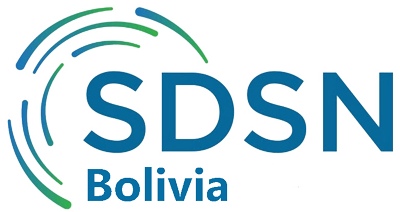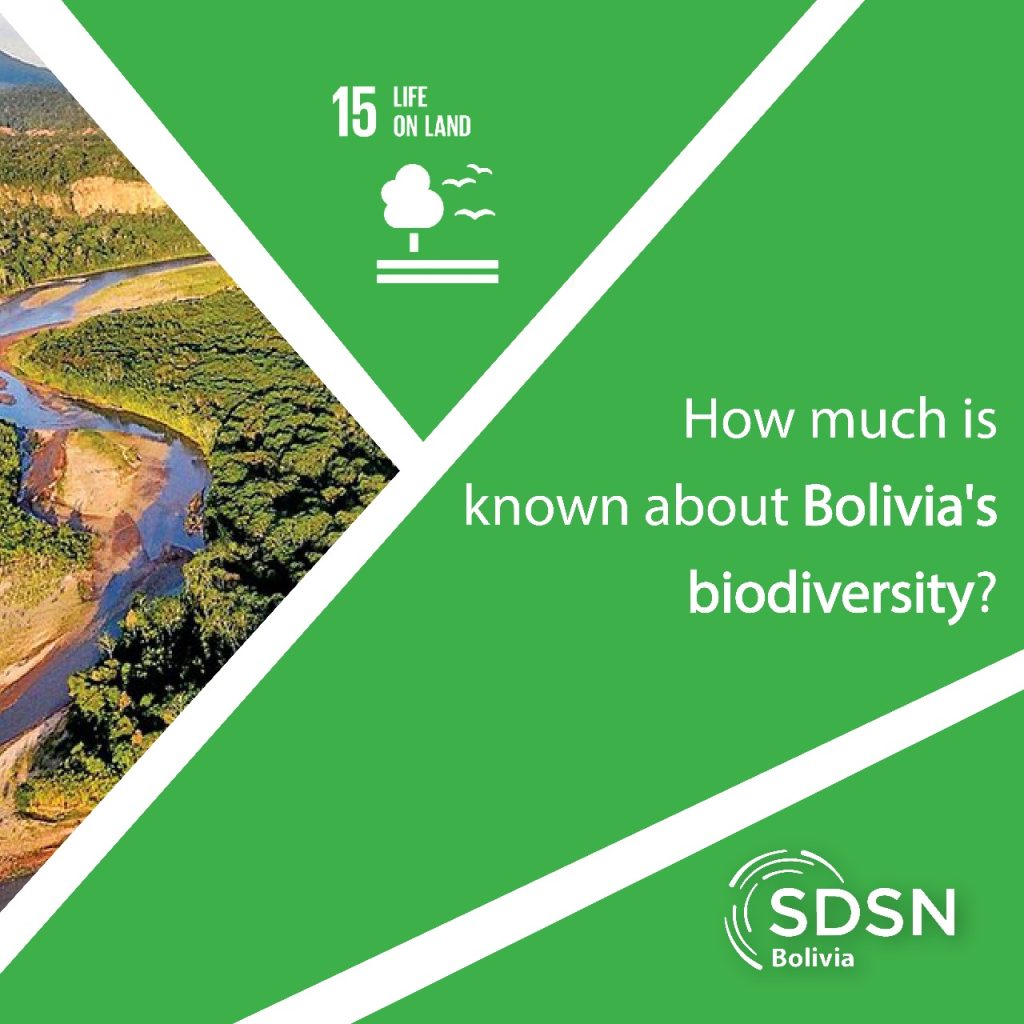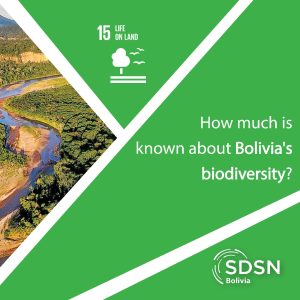April 10th, 2024

Biodiversity refers to all the different types of life on Earth, including plants, animals, bacteria and fungi that make up the natural world, from the level of genes to ecosystems. Biodiversity as a whole works in ecosystems, as an intricate network, to maintain balance and sustain life. Biodiversity supports everything we need in nature to survive: food, clean water, medicines and shelter (Costanza, R. et al., 1997). There are still many undiscovered species of global biodiversity but there are also many species threatened with extinction (Lorin, H., 2024).
Bolivia is one of the most biodiverse countries on the planet, due to its geographical location in the tropical region of South America and its wide altitudinal gradient. However, the number of species present both in Bolivia and in the rest of the world is not an exact figure; many species have yet to be discovered and many others are disappearing, some countries do not report their biodiversity and some countries have contradictory information (Nash, 2022).
Thus, in a report prepared by the Bolivian government, the fifth national report for the United Nations Convention on Biological Diversity, it was reported that Bolivia has 40 per cent of the world’s biological diversity, a fact that was not found in any other source and was not reiterated in the sixth national report. The South American office of the International Union for Conservation of Nature (IUCN), made up of governmental and civil society organisations, indicates that 40 percent of the planet’s biodiversity, 25 percent of forests and 26 percent of freshwater resources are concentrated in South America.
Although Bolivia’s percentage of the world’s biodiversity is not yet a precise and corroborated figure, the fact is that Bolivia has a large number of globally significant species and various sources place the country among the 20 countries with the greatest biological diversity in the world. In terms of biodiversity indices, Bolivia was ranked 18th place in an update to 2022 and 14th place in an update to 2023. The number of species, especially for better studied taxa such as birds, mammals and plants, stands out. Anyway, Bolivia is under-studied relative to other countries like Colombia, Brazil and Ecuador and so probably has more species for taxa which are generally given less attentions (e.g. amphibians, reptiles) and there are just more unknown species in Bolivia than elsewhere.
Table 1. Number of registered species in Bolivia.

Source: Nash, M. (2022), Arteaga J., (2020) & Butler R., (2016).
Biodiversity in Bolivia plays an important role in various aspects of the lives of some rural populations, participating in food provision, medicine and a cultural link. Therefore, the State Political Constitution (CPE) in its article 342, states that “it is the duty of the State and the population to conserve, protect and make sustainable use of natural resources and biodiversity”. Despite this, the country puts its biodiversity at risk, and one of the main causes is habitat loss due to deforestation (CBD, n.d.).
The Ministry of Environment and Water recognises that there are logistical and institutional limitations, among others, to have a better diagnosis of both the species present and the species under threat. In spite of this, it was possible to identify around 1000 species of fauna under some kind of threat, and this data is available for vertebrates in the report, which also indicates that most of these species are found in the Bolivian Yungas.
Table 2. Threatened species in Bolivia – Vertebrates

Source: MMAyA (n.d.)
One of the efforts to generate areas for biodiversity conservation and preservation is the creation of Protected Areas (PAs) and Ramsar Sites. National Protected Areas are mostly older than sub-national ones and are mainly protected by the central government. The national protected areas have better protection results than the sub-nationals, at least in deforestation terms, as we have seen in a previous blog, national protected areas suffer less from this problem, although they are not free from forest loss.
Some economic activities represent a constant threat to biodiversity conservation, for example, mining and agriculture in many regions imply deforestation or a significant degradation of environmental quality for species. It is therefore important to generate alternatives so that the development of human populations does not have to mean the imminent loss of biodiversity. In this sense, tourism is an alternative to consider; if it is carried out with planning, it can be an activity that allows the conservation of natural landscapes with all that they imply, as well as generating development and even promoting knowledge and study of natural spaces. According to the 2022 SERNAP’ accountability document the Protected Areas generated a total tourism income of 9.7 million bolivianos. Nevertheless, 78 percent of the total income was generated by the Eduardo Avaroa National Andean Wildlife Reserve, another 10 percent by the Torotoro National Park, 4 percent by the Madidi National Park and Integrated Management Natural Area and the remaining 8 percent is distributed between the other Protected Areas, of which there are several that have no tourism income at all. The high income concentrated in very few areas indicates on the one hand the achievable potential of a Protected Area in tourism income and also that there is still much that can be done to enhance tourism in the other Protected Areas.
Another form of protection is the declaration of wetlands as a Ramsar Site. Wetlands that are considered strategic in terms of their environmental functions, both nationally and internationally, can be declared Ramsar Sites; for example, wetlands used by migratory birds. Some Ramsar Sites overlap in extent with some form of Protected Area.
Map 1. Protected Areas and Ramsar Sites in Bolivia
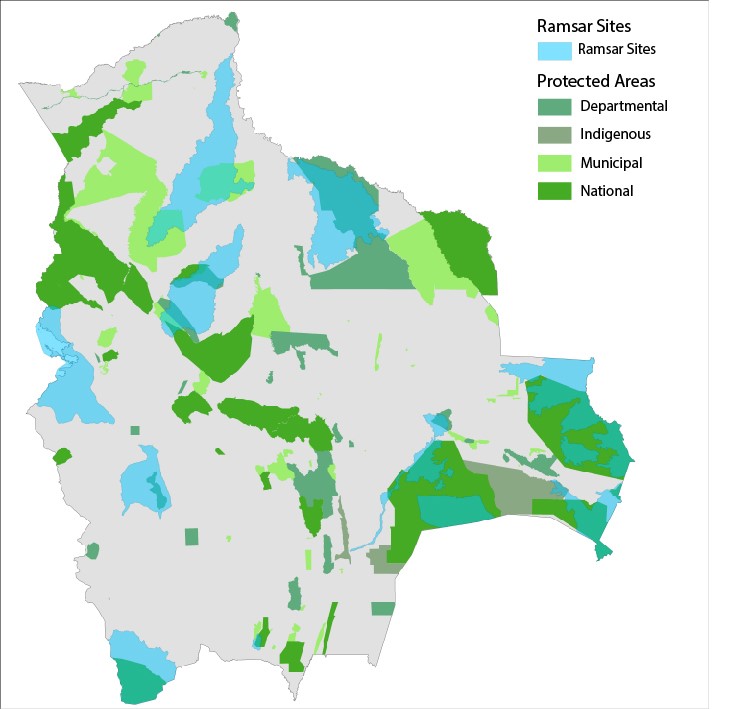
Source: SERNAP (2015), FAN (2022) & MMAyA (2020)
The declaration of Protected Areas and Ramsar Sites is an important step towards the preservation of strategic habitats for biodiversity conservation. However, working on improving the management of these areas to guarantee their effective protection is a pending task. Although small efforts have also been made in this direction, Bolivia through its Administrative Resolution NO. 085/2022 “urges the implementation of the IUCN Green List as an instrument for planning and monitoring the effectiveness of management in the national protected areas of the Plurinational State of Bolivia” (IUCN, 2022a). Currently, Bolivia has three PAs in the process of certification to be part of the IUCN Green List: 1) Beni Biological Station Biosphere Reserve; 2) Manuripi Amazonian National Wildlife Reserve; 3) Madidi Integrated Management Natural Management Area and National Park. The Green List is an international certification that meets criteria of a standard of good management for PAs, by committing to the standard, management performance can be measured, improved and maintained through consistent criteria that are assessed globally (IUCN, 2022b).
On the other hand, the presence of biodiversity is concentrated in greater numbers in places where diverse climatic, topographic, physiographic and other conditions are optimal or habitable for a greater number of species. An approximation of where the greatest concentration of biodiversity is found is obtained from the Species Richness map of Bolivia (Nowick et al. 2004), which was based on a bioclimatic model for the extrapolation of species ranges and diversity patterns (BIOM) with an approximate analysis resolution of 3.6 x 3.6 km. Although it is not a spatially precise calculation and has the limitations of any model, it gives us a clear idea of the probable concentration of biodiversity.
Map 2. Bolivia’s Absolute Species Richness, Protected Areas and Ramsar Sites
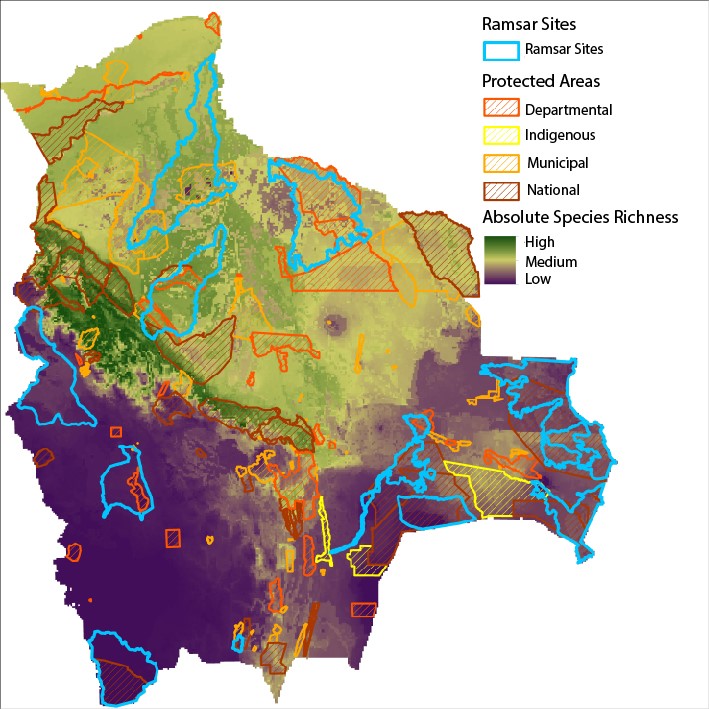
Source: Nowick et al. (2004), SERNAP (2015), FAN (2022) & MMAyA (2020)
The entire Amazon basin has a high concentration of biodiversity, particularly the Yungas region. Although the Altiplano has a lower concentration of species, each species plays a fundamental role in conserving the ecosystemic balance of this vulnerable region. For example, the wetlands and the plant species present in these wetlands make possible the presence of mammals and birds, which are few in number but indispensable for conserving biodiversity, climate regulation and even economic and agricultural activities in the Altiplano.
Madidi National Park was ranked first in the world in terms of diversity, thanks to the efforts of scientists, including the biologist, Alfredo Fuentes. This was the result of an inventory carried out at the site that brought to light 250 new plant species, Bolivia still does not have a complete inventory of plants, and worse still, inventory initiatives that support conservation have declined in recent years due to funding issues and restrictions in national regulations (Armonía, 2024).
The following table presents data on species recorded and estimated in the national Protected Areas, although there are some without precise data, so research is a necessity in these areas.
Table 3. Number of species recorded and estimated in national Protected Areas in Bolivia

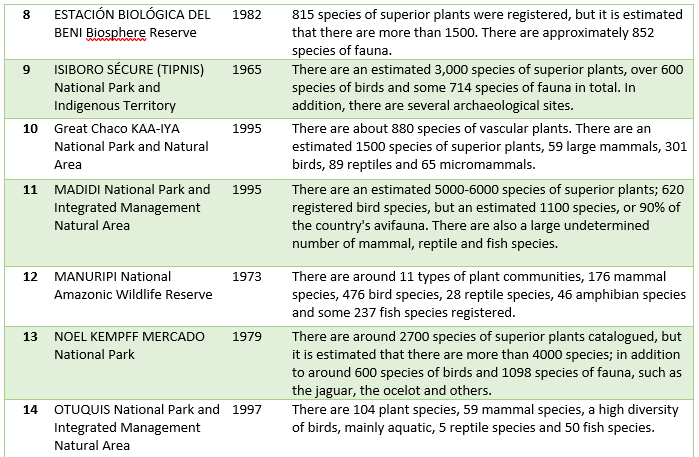
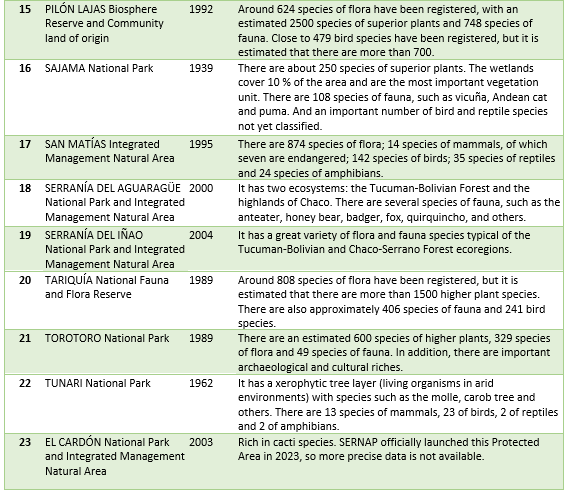
Source: Arteaga J. (2020)
Scientific exploration is still a pending task that can give us greater certainty about the presence of species, their role in the ecosystem and other functions that have a determining influence on the development of human life, such as the role of pollinators, medicinal plants and other regulators of diverse natural cycles. It is also important to take into account that some of these protected areas are inhabited by communities, so offering them economic alternatives such as tourism and sustainable use of forest resources is of vital importance so that mining and agricultural activities no longer continue to threaten biodiversity, especially in key areas for its conservation.
References
Armonía (2024). Alfredo Fuentes: Por no conocer nuestra riqueza, la estamos destrozando. Available at: https://armoniabolivia.org/alfredo-fuentes-por-no-conocer-nuestra-riqueza-la-estamos-destrozando/?fbclid=IwAR0lLF_wBAgaDAO9zuF4YRxdSxdx1_jw-tAe00qQc8UCLWF0hd2tdweMwas
Arteaga J. (2020). Áreas protegidas de Bolivia. Murillo, Bolivia: Editorial Riquezas. Available at: https://riquezasdebolivia.com/areas-protegidas-de-bolivia/
Butler R., (2016). The top 10 most biodiverse countries. Mongabay. https://news.mongabay.com/2016/05/top-10-biodiverse-countries/
CBD – Convention on Biological Diversity (s.f.). Bolivia (Plurinational State of) – Main Details. Available at: https://www.cbd.int/countries/profile/?country=bo
Costanza, R., d’Arge, R., de Groot, R. et al. The value of the world’s ecosystem services and natural capital. Nature 387, 253–260 (1997). https://doi.org/10.1038/387253a0
FAN – Fundación Amigos de la Naturaleza (2023). Mapa de Áreas Protegidas Subnacionales. Available at: https://plataforma.bolivia.mapbiomas.org/
Lorin., H. (2024). What is biodiversity? World Wildlife Fund. Available at: https://www.worldwildlife.org/pages/what-is-biodiversity#:~:text=Biodiversity%20is%20all%20the%20different,maintain%20balance%20and%20support%20life.
MMAyA – Ministerio de Medio Ambiente y Agua (n.d.). Sexto Informe Nacional al Convenio de Diversidad Biológica – Estado Plurinacional de Bolivia. Available at: https://www.cbd.int/doc/nr/nr-06/bo-nr-06-es.pdf
MMAyA – Ministerio de Medio Ambiente y Agua (2020). Mapa de Sitios Ramsar. Available at: https://geo.gob.bo/catalogue/#/dataset/2340
Nash, M. (2022). The 201 Most (& Least) Biodiverse Countries. Available at: https://theswiftest.com/biodiversity-index/
SERNAP, Servicio Nacional de Áreas Protegidas (2015). “Mapa de áreas protegidas nacionales de Bolivia” Base de datos Available at: https://geo.gob.bo/catalogue/#/dataset/1925/edit/data
UICN – Unión Internacional para la Conservación de la Naturaleza (2022a). Bolivia integra a la Lista Verde de la UICN en su estrategia nacional de gestión de áreas protegidas. Available at: https://www.iucn.org/es/noticias/202210/bolivia-integra-la-lista-verde-de-la-uicn-en-su-estrategia-nacional-de-gestion-de
UICN – Unión Internacional para la Conservación de la Naturaleza (2022b). Lista verde de la UICN. Available at: https://www.iucn.org/es/node/33337

 Español
Español